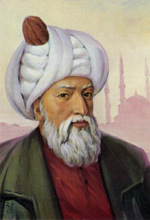Sinan The Architect
 Mimar Sinan (Ottoman Turkish: معمار سينان, romanized: Mi`mâr Sinân, Turkish: Mimar Sinan, pronounced [miːˈmaːɾ siˈnan]) (c. 1488/1490 – July 17, 1588) also known as Koca Mi`mâr Sinân Âğâ, ("Sinan Agha the Grand Architect" or "Grand Sinan") was the chief Ottoman architect (Turkish: mimar) and civil engineer for sultans Suleiman the Magnificent, Selim II, and Murad III. He was responsible for the construction of more than 300 major structures and other more modest projects, such as schools. His apprentices would later design the Sultan Ahmed Mosque in Istanbul and Stari Most in Mostar.
Mimar Sinan (Ottoman Turkish: معمار سينان, romanized: Mi`mâr Sinân, Turkish: Mimar Sinan, pronounced [miːˈmaːɾ siˈnan]) (c. 1488/1490 – July 17, 1588) also known as Koca Mi`mâr Sinân Âğâ, ("Sinan Agha the Grand Architect" or "Grand Sinan") was the chief Ottoman architect (Turkish: mimar) and civil engineer for sultans Suleiman the Magnificent, Selim II, and Murad III. He was responsible for the construction of more than 300 major structures and other more modest projects, such as schools. His apprentices would later design the Sultan Ahmed Mosque in Istanbul and Stari Most in Mostar. The son of a stonemason, he received a technical education and became a military engineer. He rose rapidly through the ranks to become first an officer and finally a Janissary commander, with the honorific title of Sinan. He refined his architectural and engineering skills while on campaign with the Janissaries, becoming expert at constructing fortifications of all kinds, as well as military infrastructure projects, such as roads, bridges and aqueducts. At about the age of fifty, he was appointed as chief royal architect, applying the technical skills he had acquired in the army to the "creation of fine religious buildings" and civic structures of all kinds. He remained in this post for almost fifty years.
His masterpiece is the Selimiye Mosque in Edirne, although his most famous work is the Suleiman Mosque in Istanbul. He headed an extensive governmental department and trained many assistants who, in turn, distinguished themselves, including Sedefkar Mehmed Agha, architect of the Sultan Ahmed Mosque and Mimar Hayruddin, architect of the Stari Most. He is considered the greatest architect of the classical period of Ottoman architecture and has been compared to Michelangelo, his contemporary in the West. Michelangelo and his plans for St. Peter`s Basilica in Rome were well known in Istanbul, since Leonardo da Vinci and he had been invited, in 1502 and 1505 respectively, by the Sublime Porte to submit plans for a bridge spanning the Golden Horn. Mimar Sinan`s works are among the most influential buildings in history.
Work
His training as an army engineer gave Sinan an empirical approach to architecture rather than a theoretical one. But the same can be said of the great Western Renaissance architects, such as Brunelleschi and Michelangelo.
Various sources state that Sinan was the architect of at least 374 structures which included 92 mosques; 52 small mosques (mescit); 55 schools of theology (medrese); 7 schools for Koran reciters (darülkurra); 20 mausoleums (türbe); 17 public kitchens (imaret); 3 hospitals (darüşşifa); 6 aqueducts; 10 bridges; 20 caravanserais; 36 palaces and mansions; 8 vaults; and 48 baths. Sinan held the position of chief architect of the palace, which meant being the overseer of all construction work of the Ottoman Empire, for nearly 50 years, working with a large team of assistants consisting of architects and master builders.
The development and maturing stages of Sinan`s career can be illustrated by three major works. The first two of these are in Istanbul: the Şehzade Mosque, which he calls a work of his apprenticeship period and the Süleymaniye Mosque, which is the work of his qualification stage. The Selimiye Mosque in Edirne is the product of his master stage.
Constructions
During his tenure during 50 years of the post of imperial architect, Sinan is said to have constructed or supervised 476 buildings (196 of which still survive), according to the official list of his works, the Tazkirat-al-Abniya. He could not possibly have designed them all, but he relied on the skills of his office. He took credit and the responsibility for their work. For, as a janissary, and thus a slave of the sultan, his primary responsibility was to the sultan. In his spare time, he also designed buildings for the chief officials. He delegated to his assistants the construction of less important buildings in the provinces.
94 large mosques (camii),
57 colleges,
52 smaller mosques (mescit),
48 bath-houses (hamam).
35 palaces (saray),
22 mausoleums (türbe),
20 caravanserai (kervansaray; han),
17 public kitchens (imaret),
8 bridges,
8 store houses or granaries
7 Koranic schools (medrese),
6 aqueducts,
3 hospitals (darüşşifa)